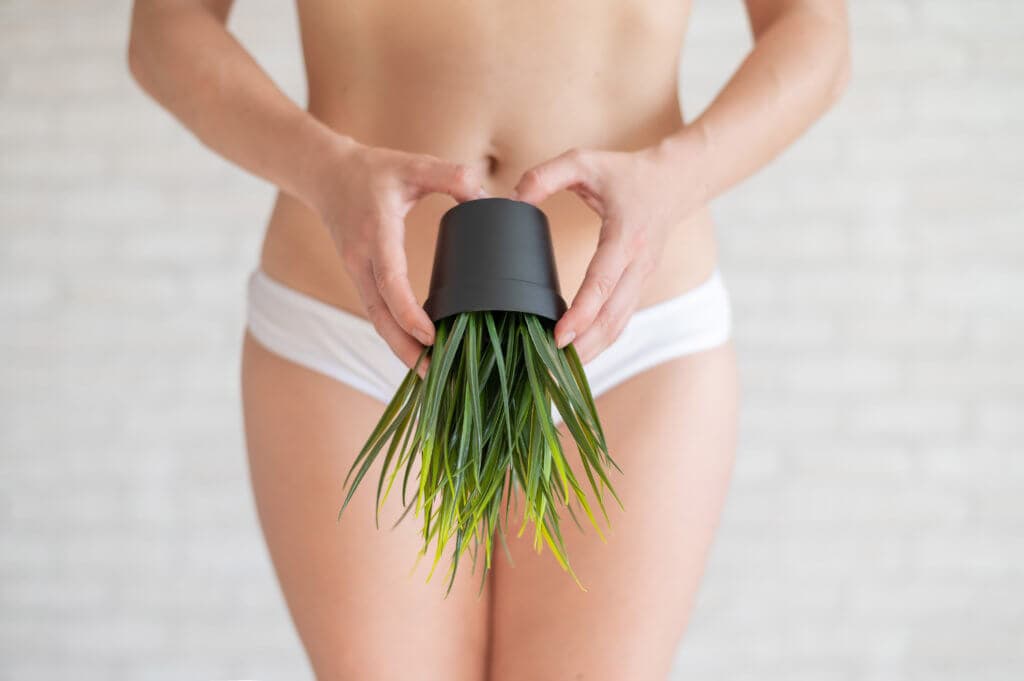Disposing of pubic hair is an integral part of proper personal hygiene. Waxing is one of several methods for removing pubic hair since it’s very effective for maintaining smooth skin. When determining which type of waxing to get, you may hear names like “Brazilian wax” or “bikini wax,” although they appear to refer to the same process.
If you are experienced and know what you are doing, you can tailor your Brazilian or bikini wax to your specific preferences. You’ll be able to locate anything that meets your requirements, whether you’re interested in taking an (at least partially) natural approach or getting rid of the hair completely. Identifying the critical ways in which bikini and Brazilian wax vary from one another is the starting point.
Bikini vs. Brazilian Wax: Breaking Down the Differences
| Feature | Bikini Wax | Brazilian Wax |
| Definition | Removes hair from the sides of the bikini line. | Removes all hair from the front to the back, including the labia and buttock area. Some variations leave a small strip or triangle in the front. |
| Coverage Area | Limited to the visible area outside a bikini. | Entire pubic area and more. |
| Pain Level | Generally less painful due to less hair being removed. | Typically more painful due to extensive hair removal. |
| Duration of Procedure | Shorter, as less hair is being removed. | Longer, given the larger area and amount of hair being removed. |
| Maintenance | Less frequent maintenance may be required as only the edges are waxed. | More frequent maintenance might be necessary to keep the area hair-free. |
| Popularity | Less popular than Brazilian but still chosen for those wanting a cleaner bikini line without full removal. | Very popular, especially for those wanting a completely smooth look. |
Hair removal in these areas is typically done for hygiene and a desire to arouse sexual interest in one’s partner. Some surveys have found that as many as 84 percent of American women get rid of their pubic hair.
Waxing your private parts can remove unwanted hair and leave them smooth for at least a few weeks at a time. It is a standard service offered in spas; some medical offices even provide it as a cosmetic option for their clients. This procedure has the additional benefit of simultaneously making the skin smoother and protecting it from razor burn. Waxing techniques such as the Brazilian and the bikini are two of the most well-known methods for removing hair from the pubic region.
In most cases, deciding between a bikini and Brazilian wax depends on personal preference and financial considerations. A bikini wax may provide you with smooth, well-manicured skin as well as hair that is smooth and well-trimmed, and it can do so in a way that is both quick and easy. On the other hand, Brazilian wax can remove hair and leave skin as smooth as a baby’s bottom if that’s your preference.
Simply put, the hair that grows outside the bikini line and underwear is the only thing traditional bikini waxing removes. A Brazilian wax not only removes hair from the anterior and posterior buttocks region but also from in between them for what we call “a truly nude image.” Brazilian waxes typically leave the front smooth, but you can request a “neat triangle, strip, or square” instead.
Historical Context
The history of hair removal traces back to ancient civilizations, where proper body grooming was seen as a sign of cleanliness and distinction. As societal norms and fashion evolved, so did the methods and reasons for removing body hair. The art of waxing, as an aspect of body grooming, predates the bikini era, but it’s the introduction of bikini bottoms that gave rise to popular types of waxes we know today, like the basic bikini wax and Brazilian waxing.
The Bikini Line Wax became popular during the 20th century, especially in Western cultures. This was mainly because of the introduction of bikini bottoms during the bikini season. As bikini bottoms shrank in size over the decades, the necessity to maintain a clean bikini line became more pressing. Regular bikini waxing came into vogue, with wax strips being employed to remove hair that would peek out of bikini-style underwear or bikini bottoms.
Brazilian waxing, on the other hand, was introduced later and is attributed to the Brazilian sisters who brought this hair removal method to New York in the late 1980s. The Brazilian bikini wax took the regular bikini wax a notch higher by removing almost all hair from the pubic bone, leaving only a strip of hair, sometimes in a rectangular shape. This was often dubbed the “honeymoon wax” for its appeal to brides.
Licensed estheticians saw an opportunity in these popular options. As time progressed, various types of bikini wax became available to cater to individual aesthetic preferences, from a basic bikini wax service, which removes hair just outside the panty line, to the French bikini wax which leaves a rectangular strip above the pubic bone, to the comprehensive bikini wax which extends the basic or G-string bikini wax to remove hair from the nether regions.
While bikini waxes were initially associated with bikini season, they have become a year-round trend for many. Moreover, with experienced estheticians and improved techniques, the waxing experience became less about pain tolerance and more about personal comfort mode. Proper aftercare, like gentle exfoliation to prevent ingrown hairs and avoiding hot water showers, became essential. Regular waxes, usually every 3-4 weeks, help in reducing hair regrowth and making the skin smooth.
However, as with most beauty treatments, there were some cons of bikini waxing to consider. Some experienced skin dryness, while others complained of ingrown hairs due to dead skin cells clogging hair follicles. Professional bikini wax treatments, however, employed soft waxes, which reduced the chances of ingrown hairs. Post-wax, using body lotion with skincare ingredients helped to maintain skin hydration and counter any skin dryness.
Muslin strips and paper strips were commonly used, but individual salon practices varied. Over the years, salons have also introduced pain relief meds and cooling methods to provide a gentler experience. The confusing salon terminology often left many deciphering the difference between a classic bikini wax, deep bikini wax, and a Brazilian bikini wax. With a plethora of bikini waxing options now available, it’s evident how these treatments have evolved from simply prepping for bikini season to becoming a regular aspect of body grooming for many.
Getting Ready for Your Bikini or Brazilian Wax Session
If you want to save time getting dressed, don’t get your hair cut too short. It was impossible to wax consumers who had shaved the area two or three days before their visit. Before obtaining a bikini or Brazilian wax, hair should be around the size of a sprinkle (1/4 inch) in length.
Bikini and Brazilian waxes require the same aftercare as any other waxing service; for example, you should avoid taking aspirin the day before your appointment to prevent excessive bruising. Likewise, it would help if you avoided harsh exfoliants since they have been shown to remove the skin’s protective layer, leaving it more susceptible to damage.
What Happens During The Appointment?
Bikini waxing is the least intrusive form of waxing for women. As the name suggests, this waxing is utilized for purposes other than the bikini line. Shaving or trimming the hair from the top and sides of the pubic triangle creates a sleek appearance. Furthermore, this guarantees that no pesky hairs will be displayed when the client dons a bikini.
On the other hand, Brazilian waxes are extremely popular among women since they semi-permanently remove hair from the vaginal area and up to the buttocks. The consumer has the last say on whether they want a triangle, landing strip, or heart drawn over their privates. To remove every last hair, the expert may have the client expose their legs or assume unnatural positions. After waxing, you may need to tweeze out any missed stray hairs.
Pain Is Unavoidable
Waxing is painful because hairs must be removed from the skin. Women who used both procedures reported roughly equivalent pain levels but found that frequent waxing helped them acclimate to the process. The hair becomes more delicate and softer with each waxing, making it easier for the esthetician to remove.
After a wax, many people also report irritation in their private areas. It can present in various ways, including redness, swelling, itchy skin, and even tiny pimples. In most cases, the symptoms will subside even if you don’t get anything for it; however, there are certain things you can do in the meanwhile, such as applying a cold compress or wearing loose clothing to reduce friction.A bikini or Brazilian wax requires a trip to a professional spa. Finding an esthetician you get along with and who has positive reviews might make the dreaded ritual of waxing much more bearable in the future.
Tips for First-Timers
Going for a bikini or Brazilian wax for the first time? It can be a bit nerve-wracking. With some easy steps, you can be more prepared and feel better. Here are some simple tips for newbies:
1. Get Your Skin Ready
- Scrub gently: Scrub your skin gently one or two days before you go. This helps get rid of old skin, letting the wax work better. This can also help avoid bumps after waxing.
- Keep skin soft: Use light lotions for a few days before your wax, but not on the day of the wax. Heavy creams can make the wax not stick well.
2. Pick a Good Place to Go
- Clean is key: Make sure where you’re going is clean. Check online comments or ask your friends where they go.
- Ask about their staff: Make sure they have trained people who know about bikini or Brazilian waxes.
- Ask questions: When you call to make an appointment, feel free to ask about what they do and the products they use.
3. Wear the Right Clothes
- Loose clothes: Wear clothes that aren’t too tight after waxing. This can help you feel better.
- Think about underwear: Some places might give you a one-time-use pair for the wax. If you’re worried about cleanliness or what feels good, bring your own.
4. Handle the Hurt
Know your limits: Some people might find it a bit painful, while others are okay. It helps to know what you can handle.
- Check your calendar: Try not to wax around your period. Your skin can be extra sensitive then.
- Consider pain relief: If you’re worried about the pain, you can take a simple painkiller an hour before. But don’t take anything that makes your blood thin.
- Breathe: It can really help to breathe in and out. The person doing the wax might also tell you when to breathe.
Types Of Wax Used
Common types of wax include hard wax (sometimes called stripless wax) and soft wax (sometimes called strip wax).
Most people picture waxing as a process in which soft wax is put in a thin layer of skin and then removed with a strip of cloth or paper. You should pay close attention to your aesthetician’s approach when getting soft wax; a new stick should be used each time it is dipped into the warmer, and repeated dipping is never allowed.
After being heated to the consistency of slime, a thick layer of hard wax is applied to the skin and peeled off without using a strip once it has cooled. Hard wax is advised for sensitive skin and places such as the underarms and the bikini line because it is generally less painful. To be safe, a test patch should be applied to the skin first, as sensitivities can differ from person to person.
Post-Waxing Care Tips to Prevent Ingrown Hairs and Irritation
Exfoliate gently: About 48 hours after your waxing session, start exfoliating the area gently 2-3 times a week. This helps to remove dead skin cells, preventing hair from becoming trapped beneath the surface, leading to ingrown hairs.
Moisturize: Keeping the skin hydrated helps maintain its elasticity, making future waxing sessions less painful. However, avoid heavy creams that could clog pores.
Avoid tight clothing: Wear loose clothing for at least 24 hours after waxing to avoid friction and irritation.
Stay cool: Refrain from hot showers, steam rooms, and saunas for at least 24 hours post-wax to prevent further irritation or burns.
Hands off: Try not to touch the waxed area with your hands to reduce the risk of introducing bacteria and causing breakouts.
How often to get waxed:
Bikini and Brazilian wax: Generally, every 3-6 weeks is recommended, but this varies depending on your hair growth rate and personal preference.
Other body parts: The frequency can vary, but most areas like legs, arms, and underarms can benefit from waxing every 4-6 weeks.
Products to use and avoid post-wax:
Use:
Aloe vera gel: This can help soothe and cool irritated skin.
Ingrown hair serums or solutions: These can help prevent and treat any ingrown hairs that might develop.
Non-comedogenic moisturizers: These hydrate the skin without clogging pores.
Avoid:
Perfumed lotions or creams: These can irritate the freshly waxed skin.
Tanning products: They can cause uneven color or further irritate the skin.
Gym workouts and sweating: Ideally, avoid any heavy sweating for 24-48 hours after waxing to reduce the risk of bacterial infections and irritation.
Harsh exfoliants: For at least the first 48 hours after waxing, avoid using products with strong acids or abrasive beads.
Cost Comparison
Bikini Wax: Prices can vary, but you might expect to pay between $50 to $100 for a bikini wax, depending on the salon and region.
Brazilian Wax: Being a more intensive procedure, Brazilian waxes generally cost more, often ranging from $100 to $150 or more.
Factors affecting the cost:
Location: Salons in metropolitan areas or high-end neighborhoods might charge more than those in smaller towns.
Expertise of the technician: Experienced waxing technicians or those with advanced certifications might charge higher rates.
Quality of the products: High-end waxes and post-care products can add to the cost.
Additional treatments: Some places might offer additional treatments like soothing masks or serums as part of the package.
Value for Money and Frequency of Appointments Needed
While Brazilian waxes may be more expensive initially, they provide more comprehensive hair removal, potentially reducing the frequency of visits compared to bikini waxes. Therefore, the overall expenditure over time might be comparable between the two, especially when considering the smoother, longer-lasting results of a Brazilian wax.
Bikini Wax
Pros:
- Less invasive: A bikini wax only removes hair that’s visible outside of a bikini or underwear line. This means less skin is exposed to the waxing process, potentially reducing the risk of irritation.
- Quicker: Since it covers a smaller area compared to a Brazilian, a bikini wax generally takes less time.
- Less painful: Fewer hair follicles are pulled at once, which can result in a less intense sensation during the process.
Cons:
- More frequent touch-ups: Hair outside the bikini line may grow back quicker or at different rates, which can mean more regular visits to maintain the desired look.
- Doesn’t provide as smooth a finish: Some hair remains, especially if it’s just inside the bikini line. This might not give the totally smooth feel that some people prefer.
Brazilian Wax
Pros:
- Smooth finish: A Brazilian wax eliminates hair entirely from the pubic area, covering from front to rear, resulting in a seamlessly smooth skin texture.
- Longer lasting results: The entire region is waxed, so you might not need to return for touch-ups as often as with a bikini wax.
- Aesthetically preferred by some: Many individuals prefer the clean, hair-free appearance of a Brazilian wax, especially when wearing certain types of swimwear or lingerie.
Cons:
- More painful: The Brazilian wax process involves removing hair from more sensitive areas, which can be more painful than a bikini wax.
- Requires more time: Given the larger and more intricate area being waxed, the process can take longer.
- May be more expensive: Due to the time and expertise needed, many salons and spas charge more for a Brazilian wax compared to a bikini wax.
How to Decide if a Brazilian or Bikini Wax is Right for You?
Choosing between a Brazilian or bikini wax depends on your personal preferences and the level of hair removal you desire. A Brazilian wax involves complete pubic hair removal, including the front of the pubic bone, external genitals, between upper thighs, and around the anus.
On the other hand, a bikini wax typically cleans up hair in the groin region, between the belly button and pubic bone, and on the sides of the bikini line. Consider how much hair you want to remove and your comfort level with complete hair removal when making your decision.
Takeaway
In short, bikini wax is different from Brazilian wax in terms of how much hair is removed. A bikini wax cleans up the area around your bikini line, leaving some hair. A Brazilian wax takes off all the hair from the front to the back, making it completely hair-free.
Think about what style you want, how much hair you’re comfortable removing, and how your skin feels. Remember, both types can be a bit painful, so it’s good to go to a professional who knows what they’re doing and keeps everything clean. Choose the one that feels right for you!
If you are interested in either of these options, feel free to contact and visit our clinic, Green Relief Health. We also provide other wellness services that you might find helpful in your aesthetic or health goals and needs.







